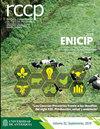超声评估盎格鲁-努比亚山羊胴体和身体性状的遗传参数
IF 0.5
4区 农林科学
Q4 AGRICULTURE, DAIRY & ANIMAL SCIENCE
引用次数: 0
摘要
背景:肉用山羊育种计划应优先鉴定和选择与肉质和胴体产量相关的遗传优良动物,以提高最终产品的价值。目的:估计巴西中北部地区饲养的盎格鲁比亚山羊胴体性状、体型和体重超声测量的方差成分和遗传参数。方法:采用单性状和双性状动物模型分析,通过贝叶斯推理,估计(Co)方差成分和遗传参数,包括腰眼尺寸(面积、长度和深度)、胸骨脂肪厚度、臀高、胸围和胸深、腿周长和体重。结果:当使用双性状分析时,遗传率估计更高。这一发现表明,由于性状之间的相关性,有可能恢复残余方差中包含的部分加性遗传方差。胴体性状与体型性状的遗传相关程度不同。另一方面,与肌肉有关的性状之间的遗传相关性显示出很高的幅度。结论:体重不是肌肉的良好指标;因此,不建议将其作为改善盎格鲁-努比亚山羊胴体性状的间接选择标准。腿围和胸围可能是肉山羊育种中重要的选择指标。本文章由计算机程序翻译,如有差异,请以英文原文为准。
Genetic parameters for ultrasound-evaluated carcass and body traits in Anglo-Nubian goats
Background: Meat goat breeding programs should prioritize the identification and selection of genetically superior animals for traits related to meat quality and carcass yield in order to increase the value of the final product. Objective: To estimate (co)variance components and genetic parameters for ultrasound-measured carcass traits, body size and body weight in AngloNubian breed goats raised in the Mid-North region of Brazil. Methods: (Co)variance components and genetic parameters were estimated using the single and two-trait animal model analyses via Bayesian inference for loin eye dimensions (area, length, and depth), sternal fat thickness, rump height, chest circumference and depth, leg perimeter, and body weight. Results: Heritability estimates were higher when two-trait analyses were used. This finding implies that it is possible to recover part of the additive genetic variance included in the residual variance due to the correlation between traits. Genetic correlations between carcass and body size traits showed different magnitudes. On the other hand, genetic correlations between the traits related to muscularity showed high magnitudes. Conclusions: Body weight was not a good indicator of muscularity; therefore, it is not recommended as a criterion for indirect selection to improve carcass traits of Anglo-Nubian goats. Leg perimeter and chest circumference may be important to construct selection indexes in meat goat breeding programs.
求助全文
通过发布文献求助,成功后即可免费获取论文全文。
去求助
来源期刊

Revista Colombiana De Ciencias Pecuarias
AGRICULTURE, DAIRY & ANIMAL SCIENCE-
CiteScore
0.80
自引率
0.00%
发文量
18
审稿时长
6-12 weeks
期刊介绍:
The editors of Revista Colombiana de Ciencias Pecuarias (RCCP) welcome the submission of original manuscripts on experimental and clinical studies associated with the broad areas of animal sciences and veterinary medicine as they interface with biochemistry, molecular biology, physiology, pharmacology, toxicology, pathology, microbiology, parasitology, immunology and epidemiology. The scope of the journal includes studies of basic and applied research in animal management and production, feeding and nutrition, reproduction, breeding, genetics, animal welfare and behavior; as well as animal production focussed from biotechnology, soil science, agrostology, silvopastoral systems, livestock economics and the environment.
The criteria for acceptance of papers submitted for publication are originality, quality and clarity of the content. Each contribution must be based on original, unpublished research that has not been simultaneously submitted to other journals. All papers will be peer reviewed. All authors bear responsibility for ensuring the integrity and quality of their reported research. It is the author''s responsibility to secure permission to use figures or tables that have been published elsewhere.
Contributions may be classified as original research, review, rapid communication, clinical case studies or methodological articles, as well as news/commentaries or letters to the editor. Most review articles are invited by the editor. Authors interested in submitting a review article should contact the corresponding editor. Rapid publication of original manuscripts is a goal of the journal. Manuscripts must be written in English. Each manuscript is considered for publication with the understanding that it has not been simultaneously submitted to any other journal. Upon acceptance for publication, papers are subject to editorial review and revision.
 求助内容:
求助内容: 应助结果提醒方式:
应助结果提醒方式:


